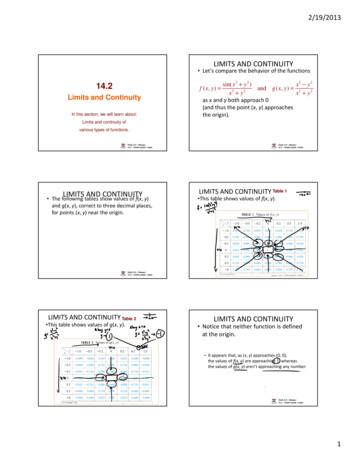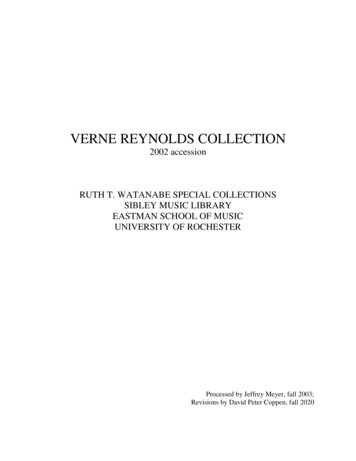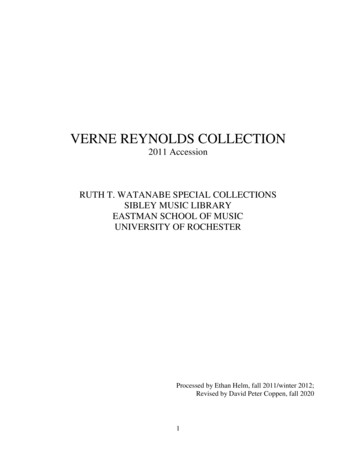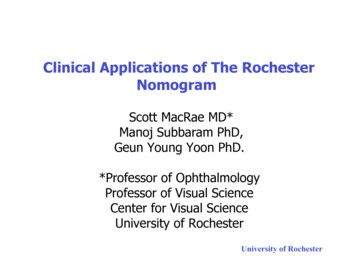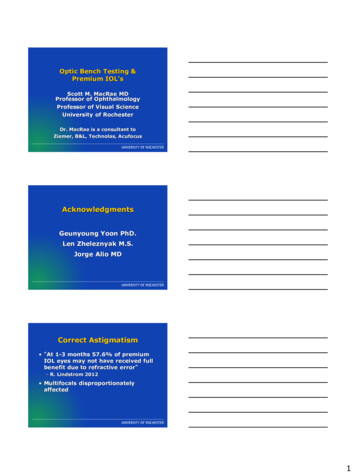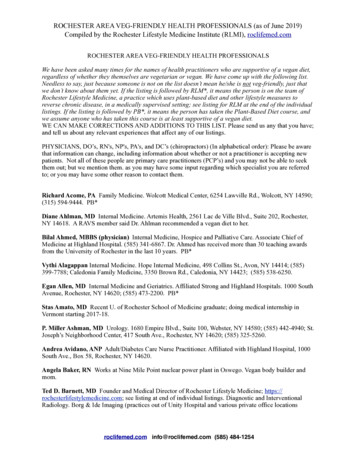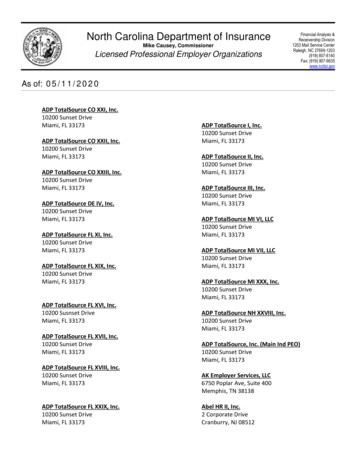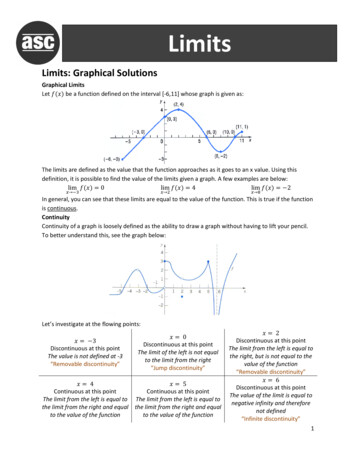
Transcription
LimitsLimits: Graphical SolutionsGraphical LimitsLetbe a function defined on the interval [-6,11] whose graph is given as:The limits are defined as the value that the function approaches as it goes to an x value. Using thisdefinition, it is possible to find the value of the limits given a graph. A few examples are below:In general, you can see that these limits are equal to the value of the function. This is true if the functionis continuous.ContinuityContinuity of a graph is loosely defined as the ability to draw a graph without having to lift your pencil.To better understand this, see the graph below:Let’s investigate at the flowing points:Discontinuous at this pointThe value is not defined at -3“Removable discontinuity”Discontinuous at this pointThe limit of the left is not equalto the limit from the right“Jump discontinuity”Continuous at this pointContinuous at this pointThe limit from the left is equal to The limit from the left is equal tothe limit from the right and equal the limit from the right and equalto the value of the functionto the value of the functionDiscontinuous at this pointThe limit from the left is equal tothe right, but is not equal to thevalue of the function“Removable discontinuity”Discontinuous at this pointThe value of the limit is equal tonegative infinity and thereforenot defined“Infinite discontinuity”1
One-Sided Limits: General DefinitionOne-sided limits are differentiated as right-hand limits (when the limit approaches from the right) andleft-hand limits (when the limit approaches from the left) whereas ordinary limits are sometimesreferred to as two-sided limits. Right-hand limits approach the specified point from positive infinity. Lefthand limits approach this point from negative infinity.The right-handed limit:The left-handed limit:A More Formal Definition of ContinuityFrom this information, a more formal definition can be found. Continuity, at a point a, is definedwhen the limit of the function from the left equals the limit from the right and this value is alsoequal to the value of the function. Using notation, for all points a where,the function is said to be continuous.A. Now you try some!4-74-47-4Determine if the following limits exists:2
Summary: When does a limit not exist? A general limit does not exist if the left-and right-hand limits aren’t equal (resulting in adiscontinuity in the function). A general limit does not exist wherever a function increases or decreases infinitely (“withoutbound”) as it approaches a given x-value. A general limit does not exist in the cases of infinite oscillation when approaching a fixed point.Limits: Numeric SolutionsNow that you know how to solve a limit graphically, you may be asking yourself: ‘That’s great, but whatabout when there isn’t a graph in the problem?’ That is a good question, and that is what this nextsection is about. There are a many better (and more accurate) ways to find the value of the limit thangraphing or plugging in numbers that get closer and closer to the value of interest. These solutionmethods fall under three categories: substitution, factoring, and the conjugate method. But first thingsfirst, let’s discuss some of the general rules for limits.Limit RulesHere are some of the general limit rules (withand1. Sum Rule: The limit of the sum of two functions is the sum of their limits()):2. Difference Rule: The limit of the difference of two functions is the difference of their limits()3. Product Rule: The limit of a product of two functions is the product of their limits()4. Constant Multiple Rule: The limits of a constant times a function is the constant times the limitof the function()5. Quotient Rule: The limit of a quotient of two functions is the quotient of their limits, providedthe limit of the denominator is not zero()Limit Rule Examples Find the following limits using the above limit rules:1.2.()3
3.()B. Now you try some!1.2.3.Limits of Rational Functions: Substitution MethodA rational function is a function that can be written as the ratio of two algebraic expressions. If afunction is considered rational and the denominator is not zero, the limit can be found by substitution.This can be seen in the example below (which is similar to the example #3 above, but now done in onequick, convenient step):This can be defined more formally as: Ifandare algebraic expressions and, then:C. Now you try some!1.2.Factoring MethodConsider the function. How would you find the limit ofasapproaches -3? If you try touse substitution to find the limit, world-ending paradoxes ensue:But fear not, this answer just tells us that we must use a different method to find the limit, because thefunction likely has a “hole” at the given x value. Therefore, the factoring method can be tried. To startthis method, the numerator and denominator must be factored (in this case the denominator is“factored” already).The factorcan be canceled to get the much simpler limit expression ofeasily be evaluated via substitution:that can4
Therefore, the result of the limit can be found, with the understanding that there is a “hole” in the graphat. Hence,.D. Now you try some!a)b)Conjugate MethodThe conjugate of a binomial expression (i.e. an expression with two terms, you can tell this because ofthe Latin root bi- meaning two) is the same expression with opposite middle signs. For example, theconjugate of is . This is really useful if you have a radical in your limit. This is becausethe product of two conjugates containing radicals will, itself, contain no radical expressions. See below:( )( ) You should use the conjugate method whenever you have a limit problem containing radicals for whichsubstitution does not work.Example:Evaluate First try the substitution method: Well, another hole in the universe, or at least the graph. Indicating that you’ll need anothermethod to find the limit since the function probably has a hole at. To start, multiply boththe numerator and denominator by the conjugate of the radical expression ( ( )( )( )( )):5
Cancel thefactor in the numerator and denominator.( )( )E. Now you try some!a) b)Formal Definition: LimitsLimits are more formally defined as“L is the limit of f(x) as x approaches a if for every numbersuch that for all x. Using notation we writeIFF , there is a corresponding number From the formal definition, right-handed limit can be defined as: And written as:Whereas the left-handed limit can be defined as: And written as:Example 1: Testing the DefinitionShow:We have to find a suitableThenis within distanceso that if that is ofand x is within distance Thus, we can take, that is if:due to the fact that , then: 6
So, if therefore, ( )and.Limits: Advanced TopicsPreviously, when we found that the result of a limit doing straight substitution yielded we usedfactoring or conjugation to be able to solve the problem. What happens when neither of those methodsprove useful? You become very grateful for the 17th-century French mathematician Guillaume deL’Hôpital. L’Hôpital was the man that derived a method of solving these types of equations, known asindeterminate forms. This method, known as L’Hôpital’s Rule, is formally defined below.Formal Definition: L’Hôpital’s RuleIf the limitAndresults in one of the following forms:exits and, then:Example 1: indeterminate form ofFind the limitUsing L’Hôpital’s Rule:Example 2: indeterminate form ofFind the limitUsing L’Hôpital’s Rule:Using L’Hôpital’s Rule again:7
Example 3: indeterminate form of(Find the limit)()Using L’Hôpital’s Rule:()Example 4: indeterminate form ofFind the limitLet. ThenUsing L’Hôpital’s Rule:ThereforeExample 5: indeterminate form ofFind the limitUsing L’Hôpital’s Rule:F. Now you try some!1.Note the trick that isneeded here – whathappens if you useL’Hôpital’s Rule withoutmaking this initial change?2.3.4.5.6. Why does the not equal ? 8
7. Early in their presentation of limits, most teachers present the following two limit facts asspecial cases:and 0. Verify each by using L’Hôpital’sRule.Limits to Infinity (Horizontal Asymptotes)What happens to a function as it goes further and further out to the left and right? Well, that dependson the function. But half of the answer can be discovered by allowing the independent variable to takeon increasingly large, positive values and keeping an eye on the output (the graph) - this investigateswhat is happening as we go further and further to the right. The other half is discovered by allowing theindependent variable to take on increasingly large, negative values and, again, keeping an eye on theoutput – this investigates what is happening as we go further and further to the left.Here are some basic facts and some generalizations that will be sufficient to evaluate most “limits toinfinity”.Consider the function as an algebraic fraction, and consider the ratio of the leading terms. Let thealgebraic expression in the numerator be expressed as n(x) and the algebraic expression found in thedenominator be expressed as d(x), then If the degree of the numerators is lower than the degree of the denominator, then. In general, whenever the denominator grows faster than the numerator, thelimit will go to zero. Thus, in these cases, as the graph extends far to both the left and the right,the output (i.e., the graph) gets closer and closer to zero.Here is a list of functions in order of their rate of growth – quickest to slowest:, , 3, 2, 1Examples:a.b. If the degree of the numerator is higher than the degree of the denominator, then. In general, whenever the numerator grows faster than thedenominator, the limit will go to positive or negative infinity. Thus, in these cases, as the graphextends far to both the left and the right, the output (i.e., the graph) increases or decreaseswithout bound. In these cases, each side needs to be considered separately.9
Examples:a.whereas[Note thatb.is meaningless since x! is not defined for negative values.] c. If the degrees are equal, then(Note thatas well [why?])is equal to the leading coefficient of n(x) over theleading coefficient of d(x).Examples:a.b. G. Now you try some!1.2.3.4.5.10
Solutions to “Now You Try Some!”A.DNE (“Doesnot exist”)B.1. 2c 52. -83. 1/5C.1. 5/22. 5/8D.1. 132. 3E.1. 42. 1/6F.1.2.3.4.5.6.3/43/7 (gets larger and larger without bound; technically this limit DNE)DNE – cannot take the logarithm of negative values1Upon substituting -1 into the numerator and denominator, we do not get one of theindeterminate forms; therefore we cannot use L’Hôpital’s Rule. More advancedmethods need to be used.1.2.3.4.5.2/1300 G.11
the limit of the denominator is not zero F G Limit Rule Examples Find the following limits using the above limit rules: 1. 2. ( ) 4 3. ( ) B. Now you try some! 1. 2. 3. Limits of Rational Functions: Substitution Method A rational function is a function that can b

